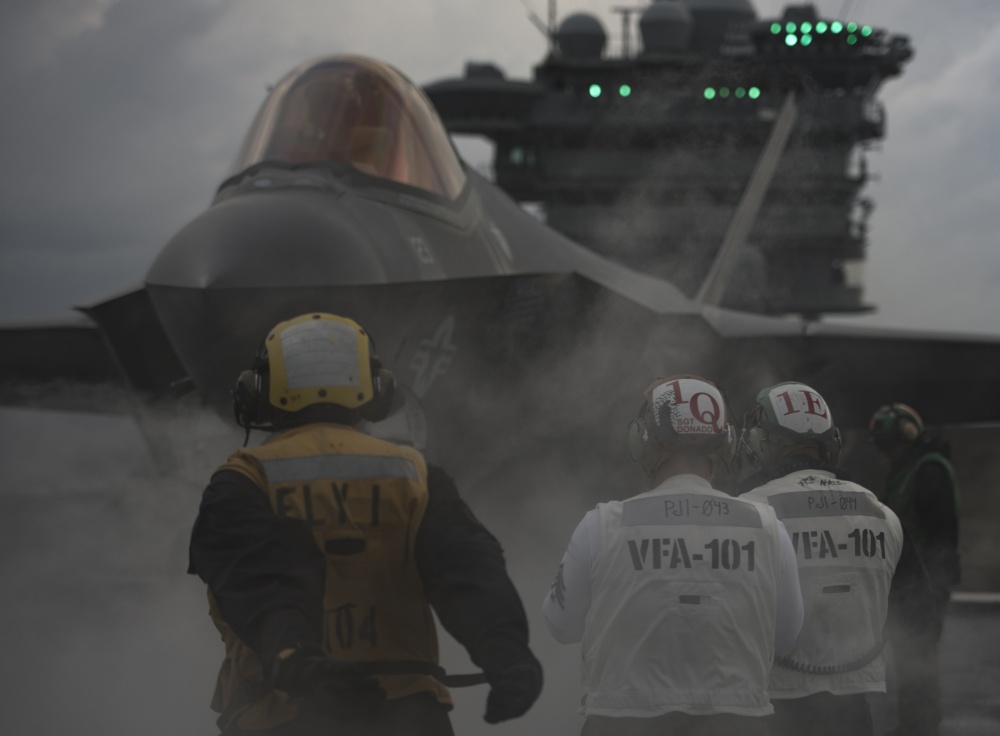
An F-35C Lightning II assigned to Strike Fighter Squadron (VFA) 101 is positioned on the bow catapults of the Nimitz-Class aircraft carrier USS Abraham Lincoln (CVN-72) March 17, 2018, in the Atlantic Ocean. US Navy photo
This post has been updated with additional information from the Navy. The service has one aircraft carrier able to deploy with F-35C Lighting II Joint Strike Fighters, USS Abraham Lincoln (CVN-72).
Currently, the Navy only has one aircraft carrier — either Ford-class or Nimitz-class — that can support the service’s most advanced fighters for a full deployment, service officials told USNI News on Thursday.
Earlier this week, lawmakers expressed their frustration with the Navy for accepting delivery of Ford-class carriers before they can accommodate deploying with F-35C Lightning II Joint Strike Fighters, while considering the Fiscal Year 2020 National Defense Authorization Act. But the Navy currently has a single Nimitz-class carrier that can deploy with F-35Cs as well, USS Abraham Lincoln (CVN-72)
“The Nimitz-class and Ford-class aircraft carriers, by design, can operate with F-35Cs, however, there are modifications to both carrier classes that are required in order to fully employ the capabilities of the F-35s and enable them to be more effective on a full-length deployment,” Capt. Daniel Hernandez, a Navy spokesman, said in an email to USNI News.
The modifications required to make each aircraft carrier class able to deploy with F-35Cs don’t require a fundamental redesign of either class. Hernandez described the modifications as involving work to support the long-term deployment of F-35Cs, such as adding classified spaces to the carriers and installing more robust jet blast deflectors.
Each class of carrier is currently able to launch and recover F-35C Lightning II Joint Strike Fighters, the variant designed for catapult launching and arrested landing on carriers. Without the carrier modifications, the ships are unable to support an F-35C for more than a short visit.
“These F-35C modifications for CVN-78 and CVN-79 are currently scheduled for a future post-delivery modernization maintenance period that will occur prior to the planned F-35C operations on those carriers,” Hernandez said. “This has always been the plan for CVN-78 and CVN-79 over several budget cycles. CVN-80 and CVN-81 will be constructed with those modifications made during construction and will not require a post-delivery modification.”
Members of the House Armed Services seapower and projection forces subcommittee sought to speed up the Navy’s modification schedule by including language in their FY 2020 NDAA mark prohibiting the Navy from accepting delivery of its next Ford-class carrier, John F. Kennedy (CVN-79) until the carrier can deploy F-35Cs.
There are no technical difficulties involving either the aircraft or the catapults and recover systems aboard the carriers that are preventing the F-35C from deploying.
The first F-35C arrested landing aboard a Nimitz-class carrier occurred on Nov. 3, 2014.
The Navy plans to make the needed carrier modifications during the next several years as carriers are available to receive the modifications. The Navy’s first F-35C squadron, VFA-147, is expected to deploy aboard USS Carl Vinson (CVN-70) in 2021, USNI News previously reported. Carl Vinson is currently in drydock at the Puget Sound Naval Shipyard and Intermediate Maintenance Facility in Bremerton, Wash., undergoing a $34.3 million dry-docking planned incremental availability, expected to be completed in July 2020, according to the Navy.
